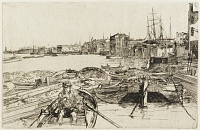Etchings Institutions search term: grolier club
The Pool | ||
| Number: | 49 | |
| Date: | 1859 | |
| Medium: | etching and drypoint | |
| Size: | 140 x 217 mm | |
| Signed: | 'Whistler.' at lower left | |
| Inscribed: | '1859.' at lower left | |
| Set/Publication: | 'Thames Set', 1871 | |
| No. of States: | 6 | |
| Known impressions: | 85 | |
| Catalogues: | K.43; M.42; T.47; W.41 | |
| Impressions taken from this plate (85) | ||
KEYWORD
TITLE
'Lighter, Jane No 6' (1861, V&A). 1
'The Pool' (1863, Royal Academy). 2
'From Tunnel Pier' (1863, Whistler). 3
'The Pool' (1871, Ellis & Green). 4
'The Pool' (1874, Ralph Thomas, Jr (1840-1876)). 5
The etching was published as 'The Pool' in the 'Thames Set' in 1871 and all subsequent cataloguers used this title.
The earliest title, 'Lighter, Jane No 6', may have been suggested by Francis Seymour Haden, Sr (1818-1910), and was based on the inscription on the boat in the foreground of the etching, but is a peripheral part of the subject. Whistler's use of 'From Tunnel Pier' may be geographically correct but is confusing because this is not the only etching done in that area.
1: 1 January 1861, V&A Register of Prints, p. 32.
2: London RA 1863 .
3: Whistler to W. H. Carpenter, 3 August 1863, GUW #11109.
4: A Series of Sixteen Etchings of Scenes on the Thames.
5: Thomas 1874 (cat. no. 47).
DESCRIPTION
SITE
6: Whistler to W. H. Carpenter, 3 August 1863, GUW #11109; see  .
.
7: W. O'Daniel, Ins and Outs of London, 1859, at http://www.victorianlondon.org / thames / thamestunnel.htm (accessed 2008).
DISCUSSION
8: Lochnan 1984 , pp. 81-82, 87, 89, 94-96, 174,
9: Lochnan 1984 , p. 89.
10: Lochnan 1984 , pp. 94-95.
